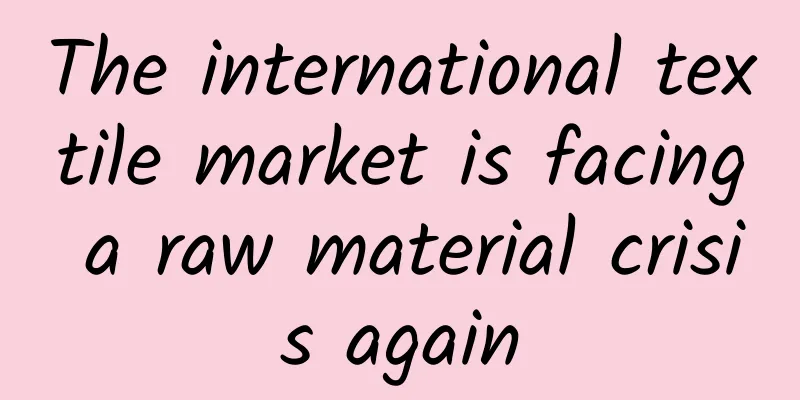The international textile market is facing a raw material crisis again

|
The global textile industry has not yet completely emerged from the shadow of the financial crisis. The recent turmoil in the European financial market caused by the Greek and Spanish debt crises and the continued fluctuations in the US dollar exchange rate are enough to make textile manufacturers in various countries tense up again. In comparison, the impact of rounds of raw material price increases on the textile industry is more rapid and direct. This "price increase trend" has spread to almost all raw material fields and even terminal markets in the textile industry. The price of raw materials represented by natural fibers such as cotton has approached the highest level in the past decade. The shock of this raw material crisis to the international textile market has been intensifying. Multiple factors push up raw material prices. When the demand in the terminal market is booming, the upstream raw materials have been continuously reduced for many years. The large imbalance between supply and demand makes this raw material crisis imminent. With the increase in employment rate driven by the global economic recovery, people's daily consumption expenditure has gradually increased, and many consumers have made "replenishment" purchases of daily consumer goods such as clothing. According to data released by the French National Institute of Statistics and Economic Statistics (INSEE), the comprehensive economic prosperity index of France, including manufacturing, service, wholesale and retail, reached 91 points in March this year, and has maintained an improving trend for 10 consecutive months. At the same time, the European Commission's consumer information index for the euro area in March also rebounded slightly. In the European and American markets, the hot sales of clothing retail brands Uniqlo and J.Crew, especially prove that after the financial crisis, consumers prefer cotton and wool products with high cost performance. Compared with the warmth of the terminal market, the upstream raw materials are experiencing a cold snap. Apart from climate and other reasons, the production reduction triggered by the low prices in the natural fiber industry for 10 years has gradually penetrated into the supply chain. The current situation of the African cotton industry is very grim. The cotton industry in Guinea-Bissau, Guinea, Niger and the Central African Republic has basically disappeared. According to data released by the African Cotton Industry Association, from 2004 to date, Africa's annual cotton production has dropped from 2.04 million tons to 1.175 million tons, a decrease of 42%; the annual output of cotton fiber has dropped from 1.2 million tons to 430,000 tons, a decrease of 64%. When the financial crisis broke out, the international cotton price fell, while the prices of production materials such as fertilizers rose, resulting in African cotton farmers' income being unable to make ends meet, their enthusiasm was severely frustrated, and they reduced production or switched production. In Australia, the world's largest wool producer, sheep farm owners have turned their attention to raising meat sheep and increased the proportion of lambs in their flocks due to factors such as the continued rise in mutton prices in recent years. As a result, Australia's wool production has continued to decline. In the international market, wool prices have been falling since 2008, especially during the financial crisis, which has greatly dampened the confidence of Australian herders in raising wool-producing sheep. In 2009, Australia's annual wool production hit the lowest level in more than 20 years. Textile companies in various countries are busy protecting themselves. Faced with the continued decline in the output of textile raw materials and the soaring prices, major textile raw material consumers and producers are staging a face show. While they are anxious or helpless, they are also resolving the impact of the shortage of raw materials in their own ways. The Bangladesh government is considering importing cotton yarn directly from some African countries to curb the recent sudden rise in cotton yarn prices. Bangladesh Commerce Minister Faruk Khan also proposed setting up a raw material warehouse to store cotton and cotton yarn to ensure that the country's woven fabric and clothing manufacturers can purchase these raw materials at relatively low prices. Pakistan, another major cotton consumer, needs to import about 3 million bales of cotton this year to meet textile production needs due to the serious shortage of cotton stocks in many textile mills. Pakistan's cotton production is expected to increase from 11.3 million bales last year to 12.7 million bales this year, but there is a big gap with the consumer demand of 15.5 million bales. India recently issued a ban on cotton exports. Cotton imported from West Africa, the United States, Brazil and other places can only be shipped to Karachi Port in July, making Pakistan's textile industry face a more severe crisis of raw material shortage. Calculated at the current international market cotton price of about 85 to 90 cents per pound, Pakistan will spend 900 million to 1 billion US dollars to import 3 million bales of cotton. In order to continue to ensure the domestic cotton yarn supply, India, which had earlier issued a ban on cotton exports, recently revealed by a senior official in the textile industry that the cotton planting area in Punjab and Hayana is expected to increase by 10% to 15%, and the cotton production is expected to reach 890,000 tons and 808,000 tons respectively. However, industry insiders predict that even at the current high price level, it may take farmers several years to increase production to a certain scale. The end market may be affected. Although it is still unclear to what extent this price surge will affect the mainstream consumer market, it is an indisputable fact that the cost burden brought to fabric and clothing companies in the middle and downstream of the entire textile industry is already an indisputable fact. These companies will face the dilemma of raising product prices or bearing the shrinking profits themselves. VF Corp, which owns the Levi's and Wrangler denim brands, is currently experiencing a sharp fluctuation in the cost of denim fabrics. The company's senior management expects that the rise in the price of fabrics with cotton as the main raw material will lead to an increase in the production cost of denim clothing at the end of this year and next year, which may in turn push up the prices of jeans, jackets and other clothing. Traditionally, denim factories charge denim makers a fixed price for fabrics they supply to jeans manufacturers between the cotton harvest seasons each year, but apparel manufacturers generally say these fabric suppliers have begun raising prices, sometimes by the week or even the day. PCCA is a denim factory located in Texas, USA, which mainly exports fabrics to factories in Latin American countries. Jack Matthews, vice president of fabric sales at PCCA, described the current price fluctuations as the craziest he has ever experienced in his career. According to statistics, in the first three months of 2010, the import of jeans in the United States increased by 12.8% year-on-year. Relevant people predict that the total demand this year will exceed the production for the third consecutive year; and the average landed cost of imported jeans this year may increase by about 3.2%. However, some industry insiders have reservations about the impact that this price increase trend will have. Sean Alim, head of merchandise purchasing at British department store chain John Lewis, said that the company's cost prices have not yet been significantly impacted because most of their inventory is purchased in advance, up to a year in advance. Other economists analyzed that high fiber prices may not seriously affect the prices of finished products, because the average proportion of raw material prices in textile production costs is about 15%. In the long run, the purchasing power and consumption power of the market have not substantially increased, but the price has increased passively due to the increase in costs. This price increase at the expense of corporate profits cannot be sustained for a long time. On the positive side, it takes some time for the price increase of upstream raw materials to affect the terminal market, and the increase in purchasing power driven by the global economic recovery may become a strong support for the terminal market for a period of time. After all, the economic crisis has made us realize that it is not the price but the consumption that causes the weakness of the terminal market. If consumers are bold in shopping driven by the economic recovery and emerging economies maintain their rapid growth momentum, the pressure caused by the raw material crisis on the terminal market will be alleviated to a certain extent. |
<<: Metro and Foxconn join hands to enter 3C stores, which may achieve a win-win situation
>>: Huawei releases 2009 Corporate Social Responsibility Report in North America
Recommend
The significance of OHSAS18000 occupational safety and health management system certification
What is the significance of OHSAS18000 occupation...
How is Yanghe Supply Chain? What are the advantages of Yanghe Supply Chain?
How about Yanghe Supply Chain? Shanghai Yanghe Su...
Made in China needs to speed up its pace
The appreciation of the RMB, the rising cost of l...
How is Bangnian International Logistics? What are the advantages of Bangnian International Logistics?
How about Bangnian International Logistics? Shang...
How to open a new eBay store? How to operate it?
As a new seller on eBay, what aspects should I st...
Majestic — Powerful link analysis tool
What is Majestic? Majestic surveys and "maps...
[eBay Newbies] Detailed Explanation of eBay Duplicate Listing Rules and Policies
Duplicate listings are a mistake that many novice...
What are the advantages of Qianmo's overseas warehouses? What are the advantages of Qianmo's shipping customs clearance?
What are the advantages of Qianmo overseas wareho...
Marketplace Growth--"One-to-one service for sellers"
Many sellers on the Amazon platform send question...
Timberland Timberland factory audit project
Timberland Timberland factory audit project 1. Chi...
Zhejiang Province Work Safety Regulations
Adopted at the 26th meeting of the Standing Commi...
JCPenney Social Responsibility Policy
JCPenney's social responsibility policy mainly...
How is Xiji.com? What services and advantages does Xiji.com have?
How about Xiji.com? Xiji (www.xiji.com) is an int...
How much is the letter of credit fee? A complete analysis of letter of credit fees~
A letter of credit is a written document issued b...
What is Unbounce? What does Unbounce do?
Unbounce was founded in 2009 and has been working...









